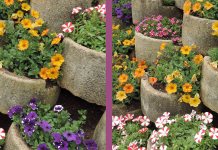Herbs have always been used to flavour food, not just in cooking but as tasty and appealing toppings or garnishes.
Herb leaves, whether chopped or used whole, add a burst of flavour, colour and texture to savoury and sweet dishes as well as drinks.
The art of garnishing is quite simple and, as the word art implies, also creative if your aim is to produce a masterpiece on a plate.
Edible flowers like nasturtiums, pansies and violas, borage, and lavender can be used to decorate desserts, cakes and other baked goods as well as cocktails, fruity drinks, and the ever popular gin and tonic.
Some tips
- Less is more: Don’t smother a dish, rather sprinkle the herbs with a light hand.
- Match the flavour, aroma and character of the herb with the other ingredients in the dish.
- Add the garnish seconds before serving so that it is still fresh and crunchy.
- Also think in terms of contrast or colour. A simple example is a tomato or butternut soup decorated with a swirl of cream and a sprinkle of chopped chives.
Safety first: Bear in mind that you should never use pesticides on your herbs or edible flowers.
5 cool season herbs to grow as garnishes:

Chives and garlic chives grow easily from seed in sun to partial shade. They will grow through winter in a sunny bed, pot or window box. Like spring onions, they form clumps but only the leaves are harvested, by snipping them off at the base. Chives have a light onion flavour while garlic chives are a mild example of garlic’s superb powers. Snip or finely chop the leaves when using as a garnish.

Rocket is an easy and quick grower from seed and grows best and lasts for longer in cooler weather. The leaves have a peppery nutty flavour, and the younger the leaves the nicer the flavour. There are two types of rocket. Wild rocket (Diplotaxis tenuifolia) has smaller, irregular leaves and are more peppery flavour than regular rocket. The more common rocket ( Eruca Vesicaria ) is also known as arugula. Young leaves are very tender and the older leaves are spicier.
Grow in moist, well composted soil.

Chervil is also known as French parsley for its lacy green leaves that are similar to parsley. The leaves have a subtle anise flavour and as a garnish it pairs well with mild egg dishes, sauces, soups and poultry. When used as a garnish, use tiny sprigs or individual leaves and sprinkle just before serving. Chervil grows in sun or semi shade.

Although parsley is an all year round herb, it prefers the cooler weather. When grown from seed it can take several weeks for the seed to germinate, but once established, seedlings are easy, quick growers that can take sun and partial shade. Regular harvesting will encourage plants to produce new leaves.
Italian “Plain Leaf Parsley’ Petroselinum (var. Filicinin) is more flavourful than Curly Parsley. It has dark flat leaves and slender stems, with a bright and slightly bitter flavour. This parsley stands up better to cooking but is also a flavourful garnish for soups and sauces to casseroles and stews.

Edible flowers like nasturtium are more of a match for savoury dishes because of their peppery flavour while pansies and violas suit deserts and drinks. Only use flowers that have been grown organically. Wash them before eating and remove the pistils and stamens. No flowers are safe to eat unless grown organically. Wash all flowers thoroughly before you eat them and remove pistils and stamen. Separate the flower petals from the rest of the flower just prior to use to keep wilting to a minimum.
For more information visit Kirchoffs.
Article and images supplied by Alice Coetzee.






